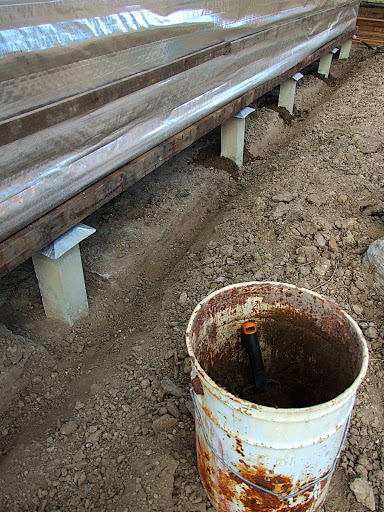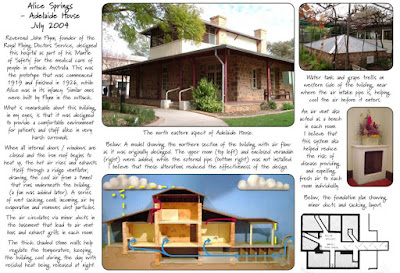Termite deterrents
Principle 6: Produce no waste
As discussed in an earlier post, I consider termites to be the greatest threat to the house. I've done further investigation and applied some of my discoveries. I'm not sure how this will proceed through council, but Peter (the architect / builder) sent this letter to council to help address their concerns:
With the understanding that termite like certain conditions for habitation, as well as cellulose for food, I have attempted to deter them by not inviting them in or readily feeding them.
The raised slab is the most vulnerable access point in the building. In order to create a clean, clear observation space around the perimeter I filled in all small gaps using motar and silicon and painted the face with a lime/milk wash. A channel was dug around the slab, where it joins the timber floor on stumps; it was filled with wood ash. Both lime and wood ash are alkaline, which termites seem not to like.
I decided to avoid the use of chemical treatments for a number of reasons:
 Mortar mix of 9 parts sand, 3 parts lime and 2 parts cement, used to fill gaps in brickwork. Silicon used to fill smaller gaps between slab insulation and cement sheet / brickwork.
Mortar mix of 9 parts sand, 3 parts lime and 2 parts cement, used to fill gaps in brickwork. Silicon used to fill smaller gaps between slab insulation and cement sheet / brickwork.
 3 coats of limewash (4 parts lime, 3 parts milk) painted over filled gaps in the 75mm inspection zone and slab insulation. The white surface reflects light (termites like dark spaces), seals the surface (termites like moist environments) and will clearly show up any mud tunnels built over it. I have also applied wood ash in a trench around the base of the slab to stump connection as an added deterrent.
3 coats of limewash (4 parts lime, 3 parts milk) painted over filled gaps in the 75mm inspection zone and slab insulation. The white surface reflects light (termites like dark spaces), seals the surface (termites like moist environments) and will clearly show up any mud tunnels built over it. I have also applied wood ash in a trench around the base of the slab to stump connection as an added deterrent.
Around the part of the house on stumps I have installed 6mm wire mesh, buried 50-75mm into the ground, along with wood ash around the base of the stumps. From a termite perspective this is a good deterrent because it creates a well ventilated, dry environment that is well lit and with alkaline conditions around major access points. While termites could theoretically climb the wire to access the house, I consider this unlikely - they would make themselves vulnerable to attack and don't like those conditions.
An added benefit the mesh is that it is strong enough to deter rodents, snakes and other animals from creating homes under the house, while also stopping leaf material and debris from collecting there (termite food). The 6mm mesh will not prevent small fire embers from passing through (3mm needed), but as there will be no easily combustible material under the house, an underfloor fire is not considered a major threat.
Some negatives using mesh include:
 Applying wood ash to the stumps around the perimeter of the building before installing the 6mm mesh. Apparently termites don't like alkaline environments, it is hoped that this application will deter them.
Applying wood ash to the stumps around the perimeter of the building before installing the 6mm mesh. Apparently termites don't like alkaline environments, it is hoped that this application will deter them.
 6mm mesh installed and about to be buried 50-75mm underground around the stumped perimeter of the stumped part of the house. The mesh will allow light and airflow in and prevent debris blowing underneath the house. It will deter termites, rodents and snakes as well as reduce fire risk.
6mm mesh installed and about to be buried 50-75mm underground around the stumped perimeter of the stumped part of the house. The mesh will allow light and airflow in and prevent debris blowing underneath the house. It will deter termites, rodents and snakes as well as reduce fire risk.
As discussed in an earlier post, I consider termites to be the greatest threat to the house. I've done further investigation and applied some of my discoveries. I'm not sure how this will proceed through council, but Peter (the architect / builder) sent this letter to council to help address their concerns:
Termite Management-->Richard Telford chooses NOT to have chemicals in/around his home.
Chemicals for termite prevention remain questionable to health safety, and are not permanent. They require intermittent further applications, and this creates problems.
The Termite Management approach for this house is a visual inspection and physical barrier regime, as provided for in the BCA Part 3.1.3.1. - Acceptable Construction Practice. A clear and permanent NOTICE identifying the termite risk and management requirement is to be placed on the completed building. This location is TBA (Building Inspector may advise).
The Termite Management System includes
- Concrete slab-on-ground- poured with aid of a vibrator to form a clear and unbroken edge of 75mm minimum (3.1.3.3);
- Suspended floors- termite shielding. All stumps fitted with a durable galvanised steel Ant Cap and all timbers 400mm clearance from the ground and good natural ventilation is provided (3.1.3.1);
- Primary Building Elements of timber are either reclaimed hardwood (termites are not readily attracted to old hardwood unless in direct contact with moist ground) OR T2 treated pine. (3.1.3)
- A regular inspection (of 6 month intervals) of all edges and stumps and plumbing intrusions is to be undertaken. The sub-floor access provides for this (area is clean and accessible).
- Further, the application of alkaline material to timber and areas most susceptible to attack is acknowledged in practice as a termite deterrent, and this approach is being adopted on this house (especially around the junction of the two floor systems).
With the understanding that termite like certain conditions for habitation, as well as cellulose for food, I have attempted to deter them by not inviting them in or readily feeding them.
The raised slab is the most vulnerable access point in the building. In order to create a clean, clear observation space around the perimeter I filled in all small gaps using motar and silicon and painted the face with a lime/milk wash. A channel was dug around the slab, where it joins the timber floor on stumps; it was filled with wood ash. Both lime and wood ash are alkaline, which termites seem not to like.
I decided to avoid the use of chemical treatments for a number of reasons:
- health risks; contamination of soil to grow food, and direct contact during inspections
- it's not long lasting, needs continual treatment
- it's very expensive
- gives a 5 year (or so) window in which regular maintenance (which still needs to be done) may be avoided, and may be forgotten until it's too late.
 Mortar mix of 9 parts sand, 3 parts lime and 2 parts cement, used to fill gaps in brickwork. Silicon used to fill smaller gaps between slab insulation and cement sheet / brickwork.
Mortar mix of 9 parts sand, 3 parts lime and 2 parts cement, used to fill gaps in brickwork. Silicon used to fill smaller gaps between slab insulation and cement sheet / brickwork.An added benefit the mesh is that it is strong enough to deter rodents, snakes and other animals from creating homes under the house, while also stopping leaf material and debris from collecting there (termite food). The 6mm mesh will not prevent small fire embers from passing through (3mm needed), but as there will be no easily combustible material under the house, an underfloor fire is not considered a major threat.
Some negatives using mesh include:
- creating more access points around the building for insects
- reduces the effectiveness of the underfloor insulation
- it will eventually need to be replaced as it corrodes over time



Comments
Good luck with your creative solution, Richard! Do keep us posted; I have friends in Mexico with a termite problem.